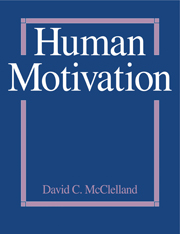Book contents
8 - The Power Motive
Published online by Cambridge University Press: 05 July 2014
Summary
• MEASURING THE NEED FOR POWER
Practically every Student of personality, from Freud to McDougall to Murray and Cattell, has found that human beings are characterized by a need for power, aggression, or domination. Anthropologists, biologists, and philosophers like Nietzsche have all been impressed by human beings' aggressive urges.
The story of how a measure for the motive involved here was finally derived is considerably more complicated than it was for the achievement motive. An early measure patterned after the scoring System for n Achievement was discovered to have some limitations and was eventually modified, expanded, and refined into the measure generally used today. The account of its development illustrates how science proceeds by trial and correction and, once again, how crucial precise measurement is in science.
The original coding System for n Power was derived by Veroff (1957) from examining the content of stories written by Student candidates for office while they were waiting for election returns to be counted. The idea was that students seeking office would be more likely than others to want power and that their power need would be more apt to be aroused while they were waiting to see if they would get power than under more neutral conditions.
- Type
- Chapter
- Information
- Human Motivation , pp. 268 - 332Publisher: Cambridge University PressPrint publication year: 1988



